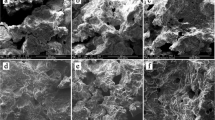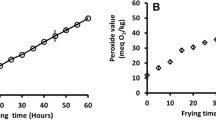Abstract
This paper presents a study on sponge cakes produced at the pilot scale and monitored during ageing (i.e. 1, 3, 6, 9, 16 and 20 day(s)) by different analytical techniques: nuclear magnetic resonance (NMR), thermogravimetric analysis (TGA) and differential scanning calorimetry (DSC). Results from NMR showed that the spin–lattice relaxation time (T 1), measured on the crumb part, decreased from day 1 to day 16 while the spin–spin relaxation time (T 2) increased throughout the whole storage time (i.e. 1 to 20 day(s)). Based on the analysis of the state of water, TGA allowed to establishing a kinetic profile of retrogradation degree of starch contained in sponge cakes. This approach evidenced that the evolution of the sponge cakes freshness and staling closely depends on the dynamic of the water in the crumb during ageing. These results were supported by DSC thermograms exhibiting a variation of three main endotherms detected in sponge cakes at −15, +5 and +45 °C throughout ageing. The enthalpy changes of these endotherms reflected the evolution of chemical and physical reactions occurring in the sponge cakes during storage. The analysis of the endotherm enthalpy change at 45 °C allowed to determine the time τ (i.e. τ ≈ 9 days) corresponding to the apparition of amylopectin crystallites that could be considered as a reference time to separate fresh sponge cakes from the aged ones.






Similar content being viewed by others
References
Assifaoui, A., Champion, D., Chiotelli, E., & Verel, A. (2006). Characterization of water mobility in biscuit dough using a low-field 1H NMR technique. Carbohydrate Polymers, 64, 197–204.
Baik, M., & Chinachoti, P. (2000). Moisture redistribution and phase transitions during bread staling. Cereal Chemistry, 77, 484–488.
Botosoa, E. P., Chèné, C., & Karoui, R. (2013a). Monitoring changes in sponge cakes during aging by front face fluorescence spectroscopy and instrumental techniques. Journal of Agricultural and Food Chemistry, 61, 2686–2695.
Botosoa, E. P., Chèné, C., & Karoui, R. (2013b). Use of front face fluorescence for monitoring lipid oxidation during ageing of cakes. Food Chemistry, 141, 1130–1139.
Breaden, P. W., & Willhoft, M. A. (1971). Bread staling. III. Measurement of the redistribution of moisture in bread by gravimetry. Journal of the Science of Food and Agriculture, 22, 647–649.
Bullerman, L. B., & Bianchini, A. (2009). Food safety issues and the microbiology of cereals and cereal products. In N. Heredia, I. Wesley, & S. García (Eds.), Microbiologically safe foods (pp. 315–335). Hoboken: Wiley.
Champenois, Y., Colonna, P., Buléon, A., Della Valle, G., & Renault, A. (1995). Gélatinisation et rétrogradation de l'amidon dans le pain de mie. Sciences des Aliments, 15, 593–614.
Chen, P. L., Long, Z., Ruan, R., & Labuza, T. P. (1997). Nuclear magnetic resonance studies of water mobility in bread during storage. Lebensmittel-Wissenschaft und-Technologie, 30, 178–183.
Curti, E., Bubici, S., Carinia, E., Baroni, S., & Vittadini, E. (2011). Water molecular dynamics during bread staling by nuclear magnetic resonance. LWT - Food Science and Technology, 44, 854–859.
Czuchajowska, Z., & Pomeranz, Y. (1989). Differential scanning calorimetry, water activity, and moisture contents in crumb center and near-crust zones of bread during storage. Cereal Chemistry, 66, 305–309.
Eliasson, A. C. (1994). Interactions between starch and lipids studied by DSC. Thermochimica Acta, 246, 343–356.
Gray, J. A., & Bemiller, J. N. (2003). Bread staling: molecular basis and control. Comprehensive Reviews in Food Science and Food Safety, 2, 1–21.
Hoseney, R. C. (1984). Chemical changes in carbohydrates produced by thermal processing. Journal of Chemical Education, 61, 308.
Kim-Shin, M. S., Mari, F., Rao, P. A., Stengle, T. R., & Chinachoti, P. (1991). 17O nuclear magnetic resonance studies of water mobility during bread staling. Journal of Agricultural and Food Chemistry, 39, 1915–1920.
Le Bail, A., Agrane, S., & Queveau, D. (2012). Impact of the baking duration on bread staling kinetics. Food and Bioprocess Technology, 5, 2323–2330.
Le Botlan, D., & Desbois, P. (1995). Starch retrogradation study in presence of sucrose by low-resolution nuclear magnetic resonance. Cereal Chemistry, 72, 191–193.
Le Grand, F., Cambert, M., & Mariette, F. (2007). NMR signal analysis to characterize solid, aqueous, and lipid phases in baked cakes. Journal of Agricultural and Food Chemistry, 55, 10947–10952.
Leung, H. K., Magnuson, J. A., & Bruinsma, B. L. (1983). Water binding of wheat flour doughs and breads as studied by deuteron relaxation. Journal of Food Science, 48, 95–99.
Luyts, A., Wilderjans, E., Van Haesendonck, I., Brijs, K., Courtin, C. M., & Delcour, J. A. (2013a). Relative importance of moisture migration and amylopectin retrogradation for pound cake crumb firming. Food Chemistry, 141, 3960–3966.
Luyts, A., Wilderjans, E., Waterschoot, J., Van Haesendonck, I., Brijs, K., Courtin, C. M., et al. (2013b). Low resolution 1H NMR assignment of proton populations in pound cake and its polymeric ingredients. Food Chemistry, 139, 120–128.
Mariette, F. (2009). Investigations of food colloids by NMR and MRI. Current Opinion in Colloid & Interface Science, 14, 203–211.
Martin, M. L., & Hoseney, R. C. (1991). A mechanism of bread firming. II. Role of starch hydrolyzing enzymes. Cereal Chemistry, 68, 503–507.
Martin, M. L., Zeleznak, K. J., & Hoseney, R. C. (1991). A mechanism of bread firming. I. Role of starch swelling. Cereal Chemistry, 68, 498–503.
Miles, M. J., Morris, V. J., Orford, P. D., & Ring, S. G. (1985). The roles of amylose and amylopectin in the gelation and retrogradation of starch. Carbohydrate Research, 135, 271–281.
Ottenhof, M.-A., & Farhat, I. A. (2004). The effect of gluten on the retrogradation of wheat starch. Journal of Cereal Science, 40, 269–274.
Piazza, L., & Masi, P. (1995). Moisture redistribution throughout the bread loaf during staling and its effect on mechanical properties. Cereal Chemistry, 72, 320–325.
Ribotta, P. D., & Le Bail, A. (2007). Thermo-physical assessment of bread during staling. LWT - Food Science and Technology, 40, 879–884.
Roca, E., Broyart, B., Guillard, V., Guilbert, S., & Gontard, N. (2007). Controlling moisture transport in a cereal porous product by modification of structural or formulation parameters. Food Research International, 40, 461–469.
Roudaut, G., van Dusschoten, D., Van As, H., Hemminga, M. A., & Le Meste, M. (1998). Mobility of lipids in low moisture bread as studied by NMR. Journal of Cereal Science, 28, 147–155.
Ruan, R., Almaer, S., Huang, V. T., Perkins, P., Chen, P., & Fulcher, R. G. (1996). Relationship between firming and water mobility in starch-based food systems during storage. Cereal Chemistry, 73, 328–332.
Schiraldi, A., Piazza, L., & Riva, M. (1996). Bread staling: a calorimetric approach. Cereal Chemistry, 73(1), 32–39.
Slade, L., & Levine, H. (1991). Beyond water activity: recent advances based on an alternative approach to assessment of food quality and safety. CRC Critical Reviews in Food Science and Nutrition, 30, 115–362.
Stawski, D. (2008). New determination method of amylose content in potato starch. Food Chemistry, 110, 777–781.
Teo, C. H., & Seow, C. C. (1992). A pulsed NMR method for the study of starch retrogradation. Starch, 44, 288–292.
Teramoto, N., Motoyama, T., Yosomiya, R., & Shibata, M. (2003). Synthesis, thermal properties, and biodegradability of propyl-etherified starch. European Polymer Journal, 39, 255–261.
Tian, Y., Li, Y., Xua, X., & Jin, Z. (2011). Starch retrogradation studied by thermogravimetric analysis (TGA). Carbohydrate Polymers, 84, 1165–1168.
Tomassetti, M., Campanella, L., & Aureli, T. (1989). Thermogravimetric analysis of some spices and commercial food products. Comparison with other analytical methods for moisture content determination (part 3). Thermochimica Acta, 143, 15–26.
Van Nieuwenhuijzen, N. H., Tromp, R. H., Mitchell, J. R., Primo-Martín, C., Hamer, R. J., & Van Vliet, T. (2010). Relations between sensorial crispness and molecular mobility of model bread crust and its main components as measured by PTA, DSC and NMR. Food Research International, 43, 342–349.
Wilderjans, E., Luyts, A., Goesaert, H., Brijs, K., & Delcour, J. A. (2010). A model approach to starch and protein functionality in a pound cake system. Food Chemistry, 120, 44–51.
Wynne-Jones, S., & Blanshard, J. M. V. (1986). Hydration studies of wheat starch amylopectin, amylose gels and bread by proton magnetic resonance. Carbohydrate Polymers, 6, 289–293.
Ye, S., Qiu-hua, W., Xue-Chun, X., Wen-yong, J., Shu-Cai, G., & Hai-Feng, Z. (2011). Oxidation of cornstarch using oxygen as oxidant without catalyst. LWT - Food Science and Technology, 44, 139–144.
Zeleznak, K. J., & Hoseney, R. C. (1986). The role of water in the retrogradation of wheat starch gels and bread crumb. Cereal Chemistry, 63(5), 407–411.
Zhiqiang, L., Xiao-Su, Y., & Yi, F. (1999). Effect of bound water on thermal behaviors of native starch, amylose and amylopectin. Starch, 51, 406–410.
Acknowledgments
We are indebted to L. Doran for her helpful technical support in DSC analysis and TGA.
Author information
Authors and Affiliations
Corresponding author
Rights and permissions
About this article
Cite this article
Botosoa, E.P., Chèné, C., Blecker, C. et al. Nuclear Magnetic Resonance, Thermogravimetric and Differential Scanning Calorimetry for Monitoring Changes of Sponge Cakes During Storage at 20 °C and 65 % Relative Humidity. Food Bioprocess Technol 8, 1020–1031 (2015). https://doi.org/10.1007/s11947-014-1467-7
Received:
Accepted:
Published:
Issue Date:
DOI: https://doi.org/10.1007/s11947-014-1467-7




